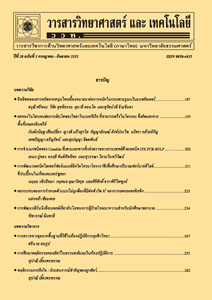การศึกษาเปรียบเทียบผลของปุ๋ยอินทรีย์และปุ๋ยเคมีต่อความสามารถในการผลิตจิงจูฉ่าย
Main Article Content
Abstract
บทคัดย่อ
ศึกษาประสิทธิภาพของการใช้ปุ๋ยอินทรีย์ต่อความสามารถในการผลิตจิงจูฉ่าย โดยวางแผนการทดลองแบบ randomized complete block design (RCBD) จำนวน 3 ซ้ำ ประกอบด้วย 6 กรรมวิธี ได้แก่ (1) ไม่ใส่ปุ๋ย (2) ปุ๋ยเคมีอัตรา 10.65 กิโลกรัม N ต่อไร่ (3) ปุ๋ยเคมีอัตรา 21.30 กิโลกรัม N ต่อไร่ (4) ปุ๋ยมูลไก่อัตรา 10.65 กิโลกรัม N ต่อไร่ (5) ปุ๋ยมูลไก่อัตรา 21.30 กิโลกรัม N ต่อไร่ และ (6) ปุ๋ยมูลไก่อัตรา 31.95 กิโลกรัม N ต่อไร่ จากผลการทดลองพบว่าการให้ปุ๋ยมูลไก่ที่เพิ่มขึ้น ทำให้สมบัติทางเคมีของดินหลังปลูกดีขึ้น โดยเฉพาะปริมาณอินทรียวัตถุ ในขณะที่ไม่พบแนวโน้มดังกล่าวในการใส่ปุ๋ยเคมี สำหรับการเจริญเติบโตและปริมาณผลผลิตที่แม้ว่าการใส่ปุ๋ยทั้งสองชนิดที่ระดับไนโตรเจนเพิ่มขึ้น ทำให้ต้นจิงจูฉ่ายมีความสูงและน้ำหนักสดต่อไร่เพิ่มขึ้น แต่จากผลของการเก็บเกี่ยวทั้ง 3 ครั้ง พบว่าการใส่ปุ๋ยมูลไก่ อัตรา 31.95 กิโลกรัม N ต่อไร่ ทำให้ต้นจิงจูฉ่ายมีน้ำหนักสดต่อไร่มากที่สุด คือ 220.39, 743.14 และ 612.87 กิโลกรัมต่อไร่ ตามลำดับ และจากการคำนวณผลตอบแทนทางเศรษฐกิจชี้ให้เห็นว่า การใส่ปุ๋ยที่เหมาะสมต่อการปลูกจิงจูฉ่ายที่ปลอดภัยและยั่งยืน คือ การใส่ปุ๋ยมูลไก่ที่อัตรา 31.95 กิโลกรัม N ต่อไร่ ซึ่งทำให้ได้ปริมาณผลผลิตและกำไรเฉลี่ยต่อกิโลกรัมมีค่ามากที่สุด
คำสำคัญ : จิงจูฉ่าย; ดิน; ปุ๋ยมูลไก่; ผลตอบแทนทางเศรษฐกิจ; ผลผลิต
Abstract
The aim of this study was to investigate the efficacy of organic fertilizer on the productivity of white mugwort. The experiment was conducted in a randomized complete block design (RCBD) with 3 replications. Six treatments were consisted of (1) no fertilizer, (2) chemical fertilizer at the rate of 10.65 kg N/rai, (3) chemical fertilizer at the rate of 21.30 kg N/rai, (4) chicken manure at the rate of 10.65 kg N/rai, (5) chicken manure at the rate of 21.30 kg N/rai and (6) chicken manure at the rate of 31.95 kg N/rai. The results showed that the increase of chicken manure provided better soil chemical properties, especially, the organic matter, while these tendencies did not observe under the chemical fertilizer treatment. For the growth and yield results, although the plant height and fresh weight increased with the rise of the nitrogen applications from both fertilizer types, the treatment of 31.95 kg N/rai of chicken manure showed the highest fresh weights that were 220.39, 743.14 and 612.87 kg/rai, respectively, at all the harvesting times. In addition to economic return, it was, therefore, considered that the most suitable fertilizer application for safe and sustainable plantation of white mugwort was the application of chicken manure at the rate of 31.95 kg N/rai, which obtained the highest yield and net profit rather than that of the other treatments.
Keywords: white mugwort; soil; chicken manure; economic return; yield


